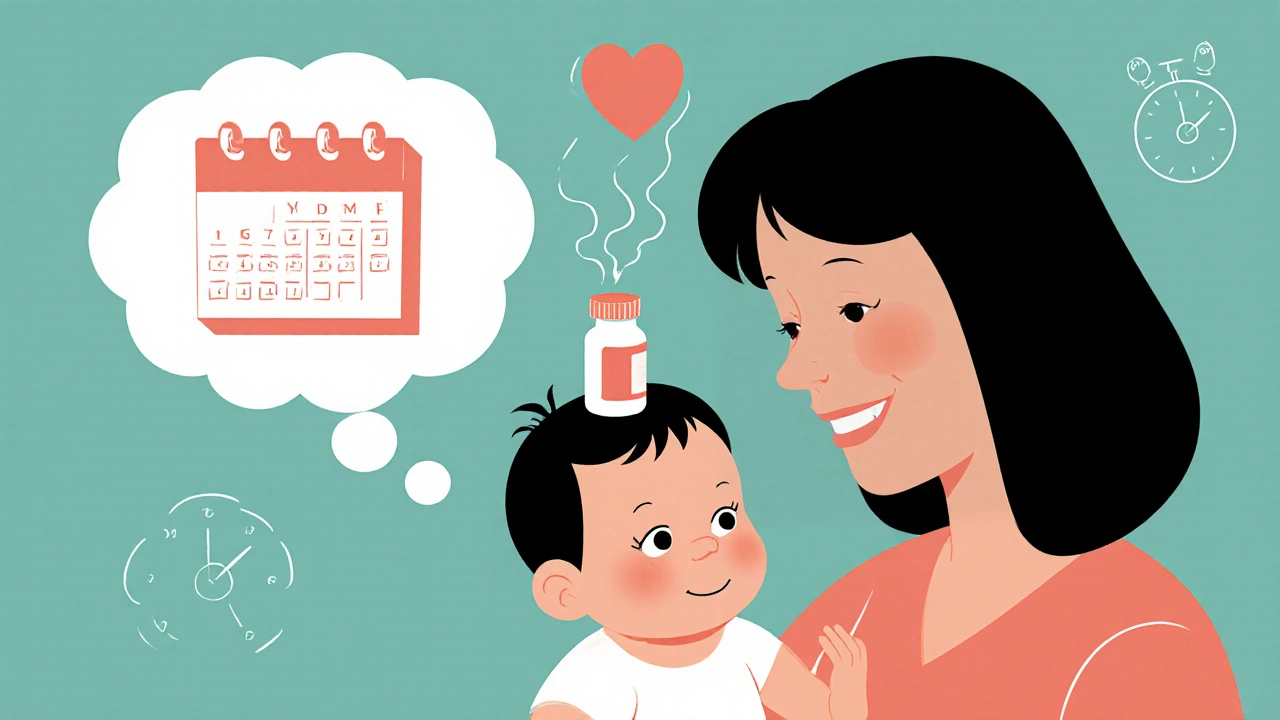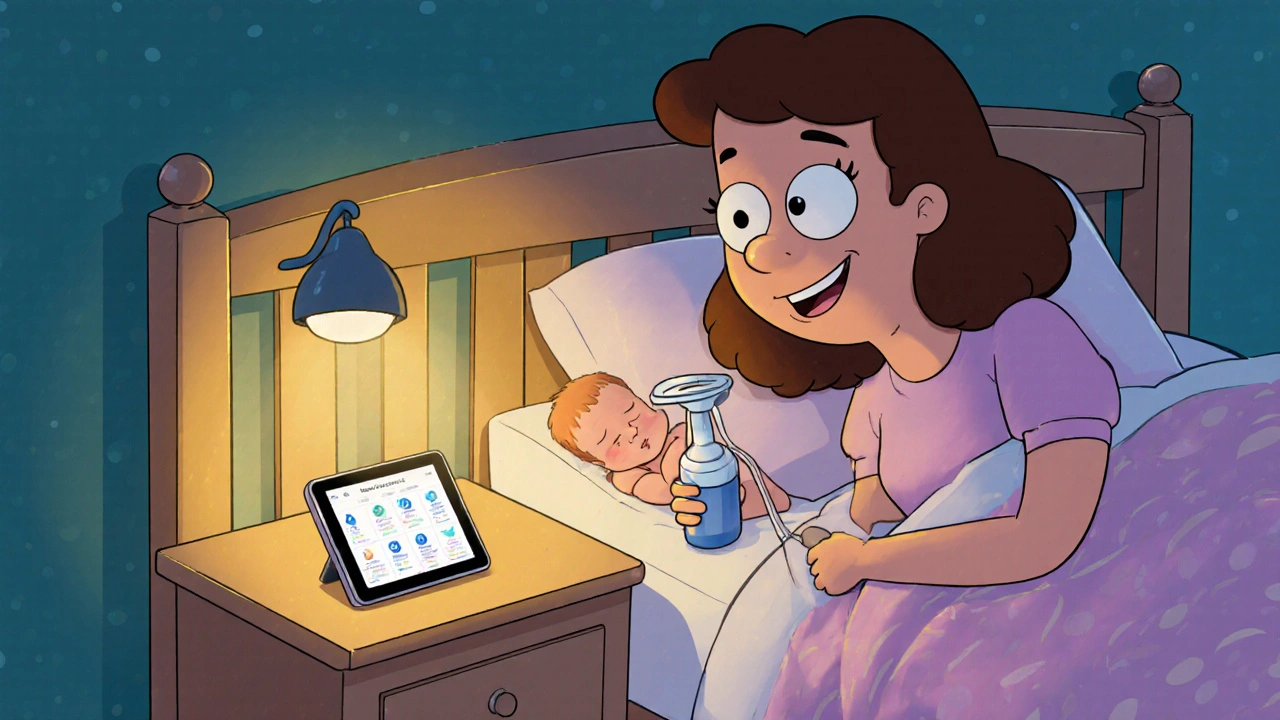When you're breastfeeding and need to take medication, the last thing you want is to panic about ruining your milk supply or harming your baby. You’ve probably heard the advice: pump and dump. But here’s the truth-most of the time, you don’t need to do it at all.
Why 'Pump and Dump' Is Usually Unnecessary
The idea that you must throw away your breast milk every time you take a pill comes from old warnings on drug labels. These labels often say, "Do not use while breastfeeding," not because the medicine is dangerous, but because manufacturers avoid liability. The reality? According to the American Academy of Pediatrics and LactMed (the National Institutes of Health’s trusted database), fewer than 1% of medications require you to stop breastfeeding. Most drugs transfer into breast milk in tiny, harmless amounts. For example, if you take 650 mg of acetaminophen (Tylenol), your baby gets less than 0.1% of that dose through your milk. Ibuprofen? Even less-about 0.01% of your weight-adjusted dose. These levels are too low to affect your baby’s health. Yet, a 2021 study in the Journal of Human Lactation found that 68% of mothers were wrongly told to dump their milk when taking common meds like antibiotics or pain relievers.When You Actually Need to Pause Breastfeeding
There are exceptions. You should temporarily stop breastfeeding only if you’re taking:- Radioactive isotopes used in diagnostic scans
- Certain chemotherapy drugs
- Ergot alkaloids (used for migraines, like ergotamine)
- Some antiretroviral drugs for HIV (depending on the regimen)
How Medications Move Into Breast Milk
Not all drugs behave the same way. The risk depends on four key factors:- Molecular weight: Drugs heavier than 500 Daltons don’t easily pass into milk. Most pills are too big to transfer well.
- Protein binding: If a drug sticks tightly to proteins in your blood (over 80%), it can’t float freely into milk.
- Half-life: Short-acting drugs (under 4 hours) clear from your system quickly. Long-acting ones (like naproxen, with a 14-hour half-life) build up and carry more risk.
- Oral bioavailability: Even if a drug gets into milk, your baby’s gut may not absorb it. Many meds are poorly absorbed by infants, making them harmless even if present.
Timing Matters More Than Dumping
Instead of throwing away milk, use timing to reduce your baby’s exposure. Here’s how:- For once-daily meds: Take your pill right after your baby’s longest sleep stretch-usually right after bedtime feeding. By the time your baby wakes up, the drug level in your milk has dropped significantly.
- For multiple daily doses: Breastfeed right before you take your pill. That way, your baby feeds during the lowest drug concentration in your milk.
- For short-acting drugs: Wait 6-8 hours after taking the dose before the next feeding. This gives your body time to clear most of it.

What About Antibiotics?
Antibiotics are one of the most common reasons moms panic. But most are safe.- Cephalexin (Keflex): Used in over 1,200 documented cases with zero adverse effects in babies.
- Amoxicillin: Very low transfer rate. Safe for newborns.
- Clindamycin (Cleocin): Higher transfer rate (5-15%) and linked to infant diarrhea in 12% of cases. Use only if no safer option exists.
Storage Rules Don’t Change
Taking medication doesn’t affect how long your milk lasts. The CDC’s 2023 guidelines still apply:- Room temperature (up to 25°C): 4 hours
- Refrigerator (up to 4°C): 4 days
- Freezer (-18°C): 6 months
What to Do When You’re Unsure
Don’t guess. Don’t rely on your pharmacist’s general advice or Google results. Use trusted resources:- LactMed (from NIH): Updated weekly, free, with scientific references. Search by drug name to see transfer rates, infant risk levels, and alternatives.
- MotherToBaby (866-626-6847): Free, confidential counseling by experts. They speak multiple languages and can help you understand your specific situation.
- InfantRisk Center: Offers a free mobile app with real-time safety ratings. Downloaded over 250,000 times.

Why So Many Moms Get It Wrong
A 2021 survey found only 32% of obstetricians and 28% of family doctors could correctly identify safe antidepressants for breastfeeding. Many still teach outdated rules because they never learned the updated science. One mom on Reddit shared: "My OB told me to dump milk for 48 hours after amoxicillin. I did, and my supply crashed. I’m still struggling to rebuild it six months later." Another said: "I used LactMed and called MotherToBaby. They said sertraline was fine. I kept breastfeeding. My baby is healthy, and my supply never dropped. I wish I’d known sooner."What You Can Do Today
If you’re on medication and breastfeeding:- Check LactMed for your specific drug.
- Call MotherToBaby if you’re unsure.
- Time your doses around feedings-not dump milk.
- Share this info with your doctor. Many don’t know the latest guidelines.
- Trust your body. Breast milk is designed to protect your baby-even when you’re on meds.
Looking Ahead
The FDA is updating drug labeling rules in 2024 to require clearer, science-based information about breastfeeding safety. Until then, rely on current data-not outdated warnings. The CDC’s 2023-2025 Breastfeeding Plan lists eliminating "unnecessary barriers" like routine pump-and-dump as a top priority. More moms are learning the truth. And with better tools, fewer will lose their supply-or their confidence-because of misinformation.Is it safe to breastfeed while taking ibuprofen?
Yes. Ibuprofen transfers into breast milk at very low levels-only 0.02-0.1 mg/L, which is about 0.01% of the maternal dose. It’s considered one of the safest pain relievers for breastfeeding mothers. Take it after feeding, and avoid long-term daily use unless advised by a doctor.
What if I take an antidepressant like Zoloft?
Sertraline (Zoloft) is one of the safest antidepressants for breastfeeding. Studies show less than 3% of the maternal dose reaches the baby, with no reported adverse effects in over 98% of cases. Many moms take it long-term without issues. Always monitor your baby for unusual sleepiness or feeding changes, but don’t stop breastfeeding because of this medication.
Should I pump and dump after taking antibiotics?
Almost never. Antibiotics like amoxicillin, cephalexin, and penicillin are safe and transfer minimally into milk. Dumping milk only harms your supply. If you’re prescribed clindamycin, monitor your baby for diarrhea-but still keep breastfeeding unless a doctor advises otherwise. Always check LactMed for your specific drug.
Can I store milk pumped while on medication?
Yes. Medications don’t change how long breast milk stays safe. Follow standard storage guidelines: 4 hours at room temperature, 4 days in the fridge, 6 months in the freezer. Label containers with the date and time you pumped, but no special handling is needed.
How do I know if a medication is safe while breastfeeding?
Don’t rely on the drug label. Use LactMed (from the NIH), MotherToBaby, or the InfantRisk Center app. These tools use real research-not liability warnings-to rate safety. If your doctor says to stop breastfeeding, ask them to check LactMed first. Most medications are safe; the exceptions are rare.


Comments (9)
Bruce Bain
18 Nov, 2025So I just took ibuprofen after my 2am feed and didn’t dump. My baby slept 5 hours straight. Turns out my milk wasn’t poison after all. Thanks for this.
Duncan Prowel
20 Nov, 2025While the general consensus presented here is scientifically sound, one must consider the variability in maternal metabolism, infant hepatic immaturity, and potential synergistic effects with other environmental toxins. The LactMed database, though invaluable, does not always account for polypharmacy scenarios or rare genetic polymorphisms in drug-metabolizing enzymes such as CYP2D6 and CYP3A4. A case-by-case pharmacokinetic assessment remains prudent, particularly in preterm or neonatal populations.
Jonathan Gabriel
21 Nov, 2025so the pharma companies write 'do not use while breastfeeding' not because it's dangerous... but because lawyers? wow. who knew the real villain wasn't the drug but the contract they signed with the lawyers? next thing you know, they'll say 'don't breathe while pregnant' because someone might sneeze and the baby gets a cold. also, why does every study say 'less than 1%' but then the mom still has to pump? i mean, if it's less than 1%, why am i paying for a pump and a freezer full of milk i'm not allowed to use? just sayin'.
also, sertraline is safe? cool. so is my cat? because my cat also doesn't do anything to my baby. but i still don't let it sleep in the crib. you see my point?
Don Angel
21 Nov, 2025Thank you. Thank you. Thank you.
I dumped milk for 3 weeks after taking amoxicillin because my OB said to. My supply dropped 70%. I cried every night. I felt like a failure. I didn't know about LactMed until my lactation consultant showed me. Now I use it every time I get a new script. Please, if you're reading this and you're on meds and breastfeeding-don't panic. Don't dump. Just check. It's not that hard.
benedict nwokedi
23 Nov, 2025Let me get this straight: the FDA, NIH, and every major medical organization say it's safe... but the 'pump and dump' myth persists because of 'liability'? That’s not liability-that’s systemic negligence. And yet, the same institutions that tell you it’s safe also refuse to force drug labels to change. Why? Because Big Pharma owns the FDA. Because they profit from fear. Because they want you to keep buying formula while you're 'dumping' your own milk. This isn’t medicine-it’s a multi-billion-dollar scam wrapped in a white coat.
And if you’re still trusting your 'doctor' who didn’t know sertraline was safe? You’re not a patient-you’re a revenue stream.
deepak kumar
24 Nov, 2025As a father of two and a nurse in Mumbai, I’ve seen this over and over: mothers stop breastfeeding because they’re scared, not because they’re told to. In India, many women don’t have access to LactMed or MotherToBaby. They rely on aunties, pharmacists, or Google. I always carry a printed cheat sheet of safe meds-amoxicillin, paracetamol, ibuprofen-and hand it out. One mother told me, 'I thought my milk turned to poison after antibiotics.' I said, 'Your milk is love. The pill is just a visitor.' She cried and kept feeding. Don’t underestimate the power of simple, clear info.
Also, please note: 'clindamycin' is spelled with two n's. Not 'clindamycin'. Just saying.
Gregory Gonzalez
26 Nov, 2025Of course it’s safe. Everything’s safe. Until it’s not. And then you’re the one holding the baby while the neonatologist explains why the liver enzymes are through the roof. You think you’re being smart by trusting a website? That’s not science-that’s crowd-sourced wishful thinking. What’s next? 'I read on Reddit that chemo is fine if you time it right after naptime.'
And yes, I know you’re going to say 'but the data!'-but data doesn’t hold your child when they’re seizing. Experience does. And experience says: when in doubt, dump.
Ronald Stenger
27 Nov, 2025Let’s be real: this whole 'pump and dump' thing is a liberal, over-medicalized myth pushed by overeducated moms who think they know more than their own bodies. In America, we’ve turned breastfeeding into a performance art. You’re not a mother-you’re a bioengineer with a breast pump schedule. Meanwhile, in real countries, women nurse while working fields, cooking, and yes-taking whatever medicine they find. Babies are fine. Why? Because nature didn’t design this to be a spreadsheet.
Also, LactMed? Sounds like a CIA project to make moms feel guilty for not having a PhD in pharmacology.
Samkelo Bodwana
28 Nov, 2025I appreciate the depth of this post, and I think it’s incredibly important to share accurate information, especially when so many mothers are left feeling isolated and afraid. I’ve seen too many women in South Africa stop breastfeeding because they were told to dump milk after a simple antibiotic, and then struggle with guilt, depression, and financial strain from buying formula. The truth is, most medications are safe, and the body is designed to protect the baby-even when we’re unwell. But what’s missing here is the emotional toll of misinformation. It’s not just about science-it’s about trust. Trust in your body, trust in your doctor, and trust that you’re doing enough. You are. And if you’re reading this and wondering whether to dump, just pause. Breathe. Check LactMed. Call MotherToBaby. And then, if you’re still unsure? Feed your baby. Because love doesn’t come with a pharmacokinetic profile. It comes with a warm chest, a quiet room, and a little one who just needs you.
Also, I just wanted to say: thank you for writing this. I’m going to share it with every new mom I meet.